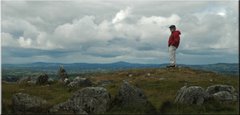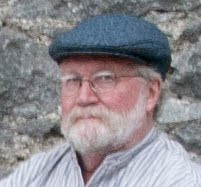
My summer school class is almost over now. The summer session at DeAnza is six weeks long; classes meet for an extended time Monday through Thursday, but do not meet at all on Friday. Looking over our schedule, Diane and I found that we had a three-week stretch in late July and early August in which we had no commitments of any kind on these bonus Fridays.
Like many other Americans, I suppose, we have been very tight with our purse strings as we learn to deal with the new economic realities. A traditional vacation of any kind was out for this summer -- not even a trip to Southern California, let alone Southern Ireland was envisioned. So we looked at those three Fridays as our summer vacation opportunity, sort of a "stay-cation" but not exactly. We called them collectively our "fake-cation."
We live in Northern California, a region that people travel thousands of miles to visit on real vacations from places like Europe, Asia, and even fabled New Jersey. So why not be tourists in our own land? After all, we wouldn't have to book flights or hotels.
Two weeks ago, we took our Friday in San Francisco, at the Chihuly exhibit in the deYoung museum in Golden Gate Park. Last week, we toured the fabulous Filoli mansion and gardens on the San Francisco peninsula. And yesterday we finished the Friday trio by driving about an hour south of Fort Harrington to the Monterey Peninsula and the Monterey Bay Aquarium.
 Fake-cation locales: Monterey, Boulder Creek, Filoli, and San Francisco. Click the image for a legible version.
Fake-cation locales: Monterey, Boulder Creek, Filoli, and San Francisco. Click the image for a legible version. Main entrance to the Aquarium. The smokestacks are from preserved boilers of the old Hovden fish cannery, within whose remodeled shell the aquarium was built. The aquarium is at the north end of Monterey's famed cannery row.
Main entrance to the Aquarium. The smokestacks are from preserved boilers of the old Hovden fish cannery, within whose remodeled shell the aquarium was built. The aquarium is at the north end of Monterey's famed cannery row. One of the most inspiring of the aquarium's exhibits is its wing devoted to jellyfish. Above, we are part of the crowd mesmerized by the rhythmic, drifting dance in the huge tank of Black Sea Nettles. (As has been the case wherever we have gone on this fake-cation, I'm struck by the number of people taking photographs where photos would have been impossible before the advent of easy digital photography -- and by the new standard posture for taking pictures: holding the camera at arm's length and looking at its lcd rather than through a viewfinder mashed up against the photographer's nose as George Eastman intended. Of course, that's not entirely new: my mother favored a twin-lens reflex camera, and the Apollo moonwalkers -- who couldn't get a camera closer to their eyes than their helmet faceplate -- used magnificent 70mm Hasselblads. In my mother's camera, she could frame a shot by looking at its projection on a ground-glass screen; the Apollo Hasselblads had no viewfinder at all! But, ah, I digress as though I was over 60.)
One of the most inspiring of the aquarium's exhibits is its wing devoted to jellyfish. Above, we are part of the crowd mesmerized by the rhythmic, drifting dance in the huge tank of Black Sea Nettles. (As has been the case wherever we have gone on this fake-cation, I'm struck by the number of people taking photographs where photos would have been impossible before the advent of easy digital photography -- and by the new standard posture for taking pictures: holding the camera at arm's length and looking at its lcd rather than through a viewfinder mashed up against the photographer's nose as George Eastman intended. Of course, that's not entirely new: my mother favored a twin-lens reflex camera, and the Apollo moonwalkers -- who couldn't get a camera closer to their eyes than their helmet faceplate -- used magnificent 70mm Hasselblads. In my mother's camera, she could frame a shot by looking at its projection on a ground-glass screen; the Apollo Hasselblads had no viewfinder at all! But, ah, I digress as though I was over 60.) Black Sea Nettles. Photographing these creatures was a challenge for me, since (like the Chihuly exhibit two weeks ago) the subjects were aglow in a very faint environment, but (unlike the Chihuly exhibit) they were also in motion.
Black Sea Nettles. Photographing these creatures was a challenge for me, since (like the Chihuly exhibit two weeks ago) the subjects were aglow in a very faint environment, but (unlike the Chihuly exhibit) they were also in motion. There are many parts of the aquarium that are geared toward children, and in them I found two kinds of critters that I did not know exist! The first was a tiny kind of fish called "Leaping Blennies"...
There are many parts of the aquarium that are geared toward children, and in them I found two kinds of critters that I did not know exist! The first was a tiny kind of fish called "Leaping Blennies"... ... and above is a blue leaping blennie resting temporarily on its little rock. The fish is about two inches long, and its jumps are not modest -- they spring several inches at a leap, and do so frequently.
... and above is a blue leaping blennie resting temporarily on its little rock. The fish is about two inches long, and its jumps are not modest -- they spring several inches at a leap, and do so frequently. I also had been unaware of sea dragons. You might not be able to make the above one out because its camouflage is so good, but once you see one...
I also had been unaware of sea dragons. You might not be able to make the above one out because its camouflage is so good, but once you see one...
... against a blank background, it becomes easier. (These dragons are only about five inches long.)


The pervasive displays geared toward children are all done in a remarkably effective and non-condescending way. The adults we saw seemed to be enjoying them as much as their children were, and the children were, pretty much, enthralled. These two images are cropped from other shots; the kids just happened to be in the frames.
 A gray whale skeleton hovers over the plaza in front of the cafeteria, and a balcony by the otter tank provides a startling nose-on view:
A gray whale skeleton hovers over the plaza in front of the cafeteria, and a balcony by the otter tank provides a startling nose-on view:
 The aquarium's exterior provides spectacular views of Monterey Bay. Above, we're looking North from a second-floor balcony across the Bay toward Santa Cruz. Barely visible in the distance are our home Santa Cruz Mountains.
The aquarium's exterior provides spectacular views of Monterey Bay. Above, we're looking North from a second-floor balcony across the Bay toward Santa Cruz. Barely visible in the distance are our home Santa Cruz Mountains. As noted before, the aquarium is situated at the north end of Cannery Row. Above, we're looking southward from the museum along Cannery Row.
As noted before, the aquarium is situated at the north end of Cannery Row. Above, we're looking southward from the museum along Cannery Row.You have to work hard to find a line of sight along Cannery Row that doesn't include an image of Steinbeck. He's on banners along the street, portraits in art galleries, and, as above, in statuary. The main gift shop in the aquarium even has a display offering copies of every one of his books. No plush toys of Lennie, though.
We had a wonderful time at the Monterey Bay Aquarium, as we did at our previous two stops on our fake-cation, but here's some advice for people who travel from outside the Bay Area: don't make this a day trip from San Francisco. The aquarium experience is at its best very early in the morning (it opens at 9:30) and gets very, very crowded in the summer months after noon. Staying a night in one of the many good hotels or decent motels in the Monterey area will allow you to take in the whole aquarium during the morning hours and free the afternoon for touring the Monterey Peninsula, Carmel, and Big Sur (providing, of course, that they are not on fire at the time of your visit.)











6 comments:
Someplace or other, I used to be able to pick up the Monterey Aquarium's little wallet-sized list of fish that were okay to buy at the grocery store and ones that you probably should pass up for ecological reasons. Nice to see where the list originated, though I also remember that the aquarium has a very nice web presence.
Yes, indeed, Mike, the aquarium has a rich and well-organized website. It includes the list you refer to, customized for various regions of the U.S.
Quote: "(providing, of course, that they are not on fire at the time of your visit.)"
Now there is useful tourism advice!
Three for three, Sherwood. Great post.
I noticed the spanish translation for "Leaping Blennies" is "Drunken Saltarines". Strange.
Adam-
Hey Sherwood,
Wonderful photos again! You're becoming quite a master of photography in low-light conditions that turns out beautifully rich and colourful. (Not, I'm afraid, like my bleak recent efforts, but different conditions.)
We've taken the same route this summer - "fakations". We took a four-day weekend to Yarmouth and the Annapolis Valley of NS, an overnight trip to Halifax, and will be attending a wedding in Sussex later this month. Being a tourist in your own region is a lot more fun that people think it will be until they try it!
ronnie
These really are exceptional photos, because they show such cool light and color, but also convey that other-worldly feel of quiet and (relatively, to us!) freedom from gravity. We have a little aquarium in MB and it's wonderfully serene - at least on a nice off-season weekday!
Post a Comment